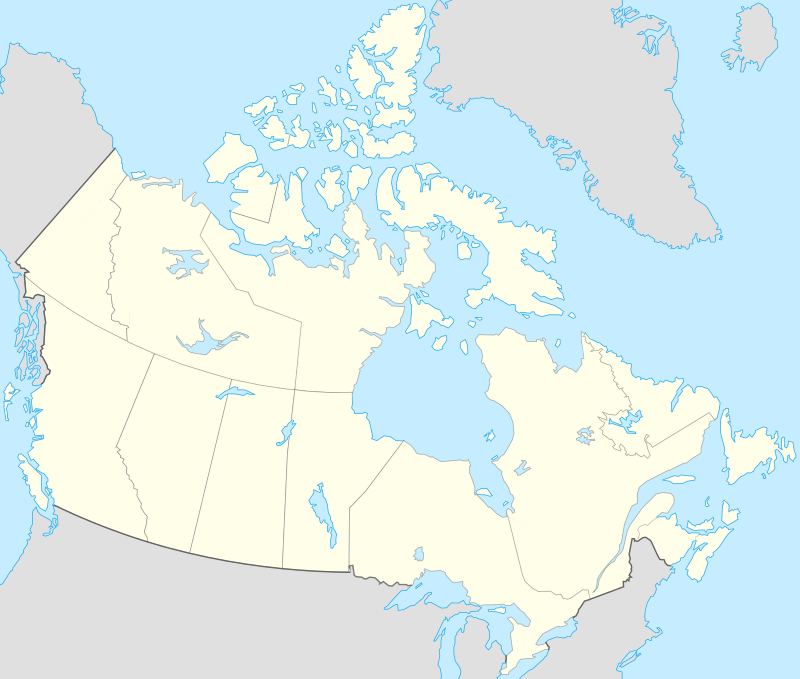Japanese Canadians
Japanese Canadians (日系カナダ人, Nikkei Kanadajin, French: Canadiens japonais) are Canadian citizens of Japanese ancestry. Japanese Canadians are mostly concentrated in Western Canada, especially in the province of British Columbia, which hosts the largest Japanese community in the country with the majority of them living in and around Vancouver. In 2016, there were 121,485 Japanese Canadians throughout Canada.[1]
日系カナダ人 Nikkei Kanadajin | |
|---|---|
| Total population | |
| 121,485 (by ancestry, 2016 Census)[1] | |
| Regions with significant populations | |
| British Columbia, Alberta, Ontario, Quebec | |
| Languages | |
| English, French, and Japanese | |
| Religion | |
| Buddhism, Shinto, Christianity, Irreligion, Japanese new religions | |
| Related ethnic groups | |
| Japanese, Japanese Americans, Japanese Brazilians, Japanese Peruvians, Japanese Mexicans |
Generations
The term Nikkei (日系) was coined by sociologists and encompasses all of the world's Japanese immigrants across generations. Japanese descendants living overseas have special names for each of their generations. These are formed by combining one of the Japanese numerals with the Japanese word for generation (sei 世):
- Issei (一世) – The first generation of immigrants, born in Japan before moving to Canada.
- Nisei (二世) – The second generation, born in Canada to Issei parents not born in Canada.
- Sansei (三世) – The third generation, born in Canada to Nisei parents born in Canada.
- Yonsei (四世) – The fourth generation, born in Canada to Sansei parents born in Canada.
- Gosei (五世) – The fifth generation, born in Canada to Yonsei parents born in Canada.
History
The first Japanese settler in Canada was Manzo Nagano, who lived in Victoria, British Columbia in 1877 (a mountain in the province was named after him in 1977). The first generation, or Issei, mostly came to Vancouver Island, the Fraser Valley and Rivers Inlet from fishing villages on the islands of Kyūshū and Honshū between 1877 and 1928. Since 1967, the second wave of immigrants were usually highly educated and resided in urban areas.[2]
Until 1948, Japanese-Canadians, both Issei and Canadian-born Nisei, were denied the right to vote. Those born in the 1950s and 1960s in Canada are mostly Sansei, the third generation. Sansei usually have little knowledge of the Japanese language. Over 75% of the Sansei have married non-Japanese. Nisei and Sansei generally identify themselves not as fully Japanese but first as Canadians first who happen to have Japanese ancestry.
The younger generation of Japanese-Canadians born in the late 20th century are mostly Yonsei, the fourth generation. Many Yonsei are of mixed racial descent. According to Statistics Canada's 2001 census of population information, Japanese-Canadians were the Canadian visible minority group most likely to have a formal or common-law marriage with a non-Japanese partner. Out of the 25,100 couples in Canada in 2001 that had at least one Japanese person, in only 30% of them were both partners of Japanese descent. As of 2001, 65% of Canada's Japanese population was born in Canada.
Internment
In 1942, the Canadian government used the War Measures Act to brand Japanese-Canadians enemy aliens and to categorize them as security threats. There were 20,881 Japanese placed in internment camps and road camps in British Columbia;l and prisoner-of-war camps in Ontario. Families were also sent as forced labourers to farms throughout the prairies. Three quarters of them were already citizens in Canada. A parallel situation occurred in the United States, the Japanese American internment.[3]
The property and homes of Japanese Canadians living in the province of British Columbia were seized and sold off without their consent in 1943. The funds were used to pay for their internment. They also had to "pay rent" for living in the internment shacks that they were assigned. In 1945, after the war, as part of the continued effort to remove all Japanese Canadians from British Columbia, Prime Minister William Lyon MacKenzie King had his cabinet pass Orders-in-Council to extend the powers of the War Measures Act and Japanese Canadians give two "options:" to be relocated to another province "East of the Rockies" or to go "back" to Japan though most were born in Canada and had never been to Japan. After organized protests by against their treatment, they were finally given the right to vote in 1949. Mobility restrictions were lifted in 1949.
In the late 1970s and the 1980s, documents on the Japanese Canadian internment were released, and redress was sought by the National Association of Japanese Canadians, an organization representing Japanese Canadians nationally that was headed by Art Miki from Winnipeg. In 1986, it was shown that Japanese Canadians had lost $443 million during the internment. There were 63% of Canadians who supported redress and 45% who favoured individual compensation. On September 22, 1988, the National Association of Japanese Canadians succeeded in negotiating a redress settlement with the government at the time, under the leadership of Prime Minister Brian Mulroney. The settlement included $21,000 for each individual directly affected, which was by 1993 almost 18,000 survivors. The federal government also provided a community endowment fund to assist in rebuilding the community, which is run by the National Association of Japanese Canadians. In addition, to address the more systemic racism that led to the plan and later justifications of the effort to remove "all people of Japanese racial origin" from Canadian territory, the redress settlement included the establishment of the Race Relations Foundation and challenges to the War Measures Act. The Prime Minister also offered a formal apology in the House of Commons and the certificate of acknowledgement of injustices of the past, which was sent to each Japanese Canadian whose rights had been stripped, incarcerated, dispossessed and forcibly displaced.
Education
Hoshū jugyō kō (Japanese supplementary schools) for instruction of the Japanese language include those in Calgary, Edmonton, Halifax, London, Montreal, Ottawa, Saskatoon, Toronto, and Vancouver.[4]
With teachers from Japan:
- Toronto Japanese School
- Vancouver Japanese School (バンクーバー補習授業校, Bankūbā Hoshū Jugyō Kō) - Established on April 7, 1973 (Showa Year 48).[5]
Without teachers from Japan:[4]
Demographics
| Year | Pop. | ±% |
|---|---|---|
| 1901 | 4,738 | — |
| 1911 | 9,067 | +91.4% |
| 1921 | 15,868 | +75.0% |
| 1931 | 23,342 | +47.1% |
| 1941 | 23,149 | −0.8% |
| 1951 | 21,663 | −6.4% |
| 1961 | 29,157 | +34.6% |
| 1971 | 37,260 | +27.8% |
| 1981 | 40,995 | +10.0% |
| 1986 | 54,505 | +33.0% |
| 1991 | 65,680 | +20.5% |
| 1996 | 77,130 | +17.4% |
| 2001 | 85,225 | +10.5% |
| 2006 | 98,905 | +16.1% |
| 2011 | 109,740 | +11.0% |
| 2016 | 121,485 | +10.7% |
Japanese Canadians by province or territory
Japanese Canadian population by province and territory in Canada in 2016 according to Statistics Canada:
| Province or territory | Japanese Canadians | Percentage |
|---|---|---|
| 121,485 | 0.3% | |
| 51,145 | 1.0% | |
| 41,645 | 0.3% | |
| 16,595 | 0.4% | |
| 6,495 | 0.0% | |
| 2,645 | 0.2% | |
| 1,225 | 0.1% | |
| 900 | 0.0% | |
| 310 | 0.1% | |
| 110 | 0.1% | |
| 95 | 0.3% | |
| 105 | 0.0% | |
| 200 | 0.6% | |
| 15 | 0.0% |
Gallery
.jpg)
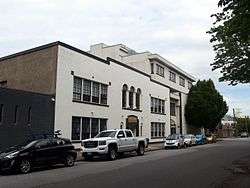 Vancouver Japanese Language School in Vancouver, BC is the oldest Japanese language school in Canada.
Vancouver Japanese Language School in Vancouver, BC is the oldest Japanese language school in Canada.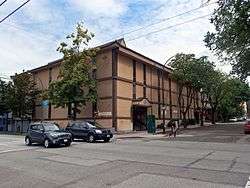 Vancouver Buddhist Temple in Vancouver, BC.
Vancouver Buddhist Temple in Vancouver, BC.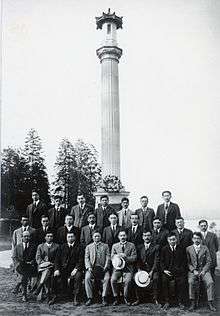 Founding members of the Canadian Japanese Association at the Japanese Canadian War Memorial in Stanley Park, Vancouver, BC.
Founding members of the Canadian Japanese Association at the Japanese Canadian War Memorial in Stanley Park, Vancouver, BC.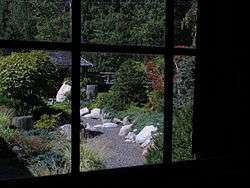 Nikkei Internment Memorial Centre in New Denver, BC is designated as a National Historic Site of Canada.
Nikkei Internment Memorial Centre in New Denver, BC is designated as a National Historic Site of Canada.
Notable People
- Ken Adachi (1929-1989), Journalist
- Joy Kogawa (b.1935), Author
- Keegan Messing (b.1992), Figure Skater
- Art Miki (b.1936), Activist
- Roy Miki (b.1942), Poet, Scholar
- Manzo Nagano (1855-1923), Pioneer, Entrepreneur
- Gordon Goichi Nakayama (1900-1995), Anglican Priest
- David Suzuki (b.1936), Environmentalist, Documentarian
See also
- Asian Canadians
- Japanese in Toronto
- Japanese Americans
- East Asian Canadians
- Judo in Canada
- Reference re Persons of Japanese Race
- The Vancouver Asahi, 2014 Japanese film described Asahi (baseball team)
References
- Statistics Canada. "2011 National Household Survey: Data tables". Retrieved 11 February 2014.
- Ken Adachi, The enemy that never was: A history of the Japanese Canadians (McClelland & Stewart, 1976)
- Ann Gomer Sunahara, The politics of racism: The uprooting of Japanese Canadians during the Second World War (James Lorimer & Co, 1981)
- "北米の補習授業校一覧(平成25年4月15日現在)." () MEXT. Retrieved on May 5, 2014.
- Home page. Vancouver Japanese School. Retrieved on April 2, 2015.
- "トップページ." Calgary Hoshuko Japanese School Association. Retrieved on February 15, 2015.
- "Time/Location." Metro Edmonton Japanese Community School. Retrieved on February 15, 2015.
- "Contact." The Ottawa Hoshuko. Retrieved on February 15, 2015. "日本大使館 領事班 オタワ補習校事務局 (住所)255 Sussex Dr., Ottawa, ON"
Further reading
- Adachi, Ken. The enemy that never was: A history of the Japanese Canadians (McClelland & Stewart, 1976)
- Sunahara, Ann Gomer. The politics of racism: The uprooting of Japanese Canadians during the Second World War (James Lorimer & Co, 1981)
- Ward, W. Peter, The Japanese in Canada (Canadian Historical Association Booklets, 1982) online 21pp
External links
- Multicultural Canada website images in the BC Multicultural Photograph Collection and digitized issues of The New Canadian (Japanese-Canadian newspaper) and Tairiku Jiho (The Continental Times)
- Japanese Canadians Photograph Collection – A photo album from the UBC Library Digital Collections chronicling the treatment of Japanese Canadians in British Columbia during World War II
- Tairiku Nippō – Japanese-Canadian newspaper published between 1907 and 1941, and now digitized by the UBC Library Digital Collections
